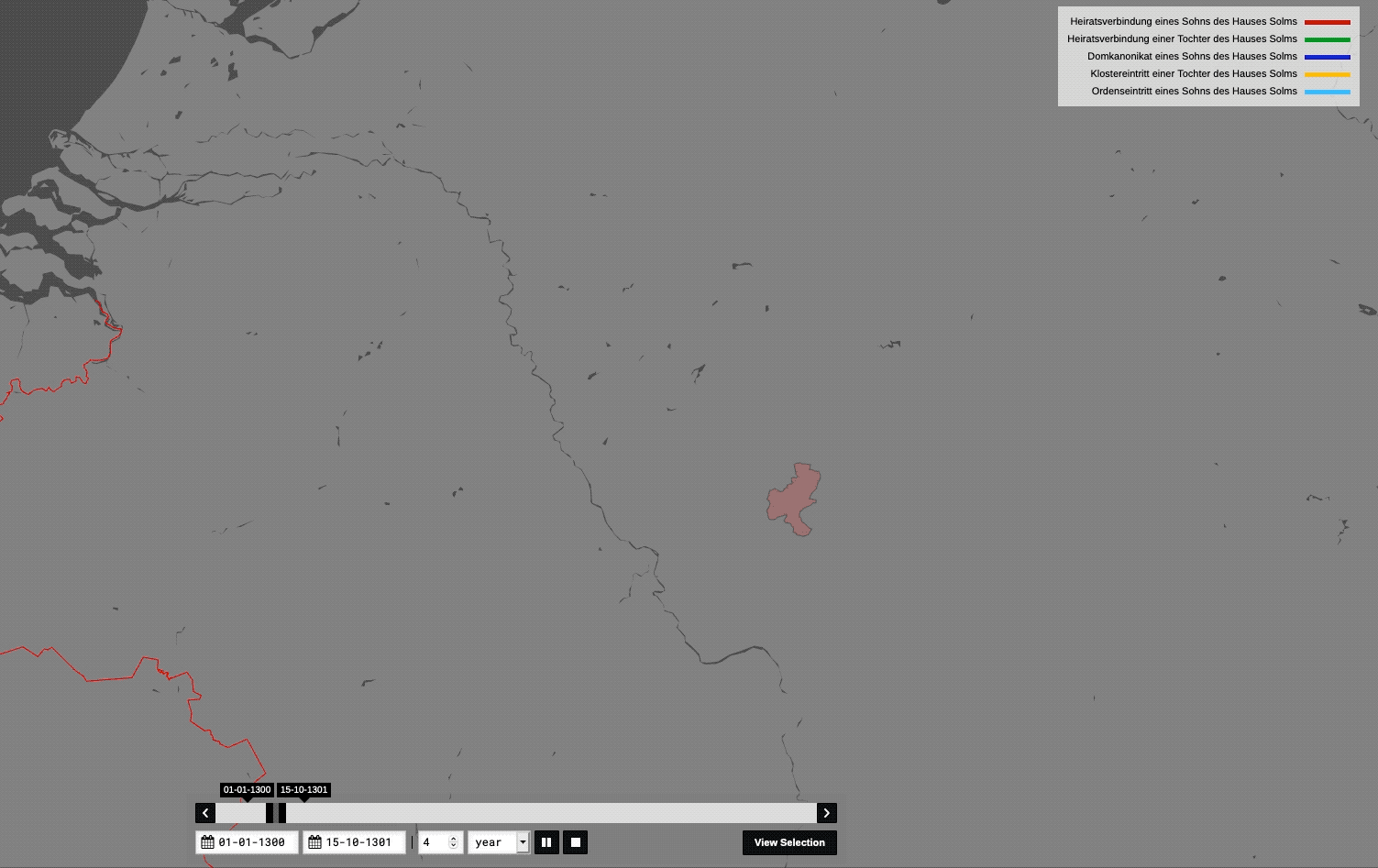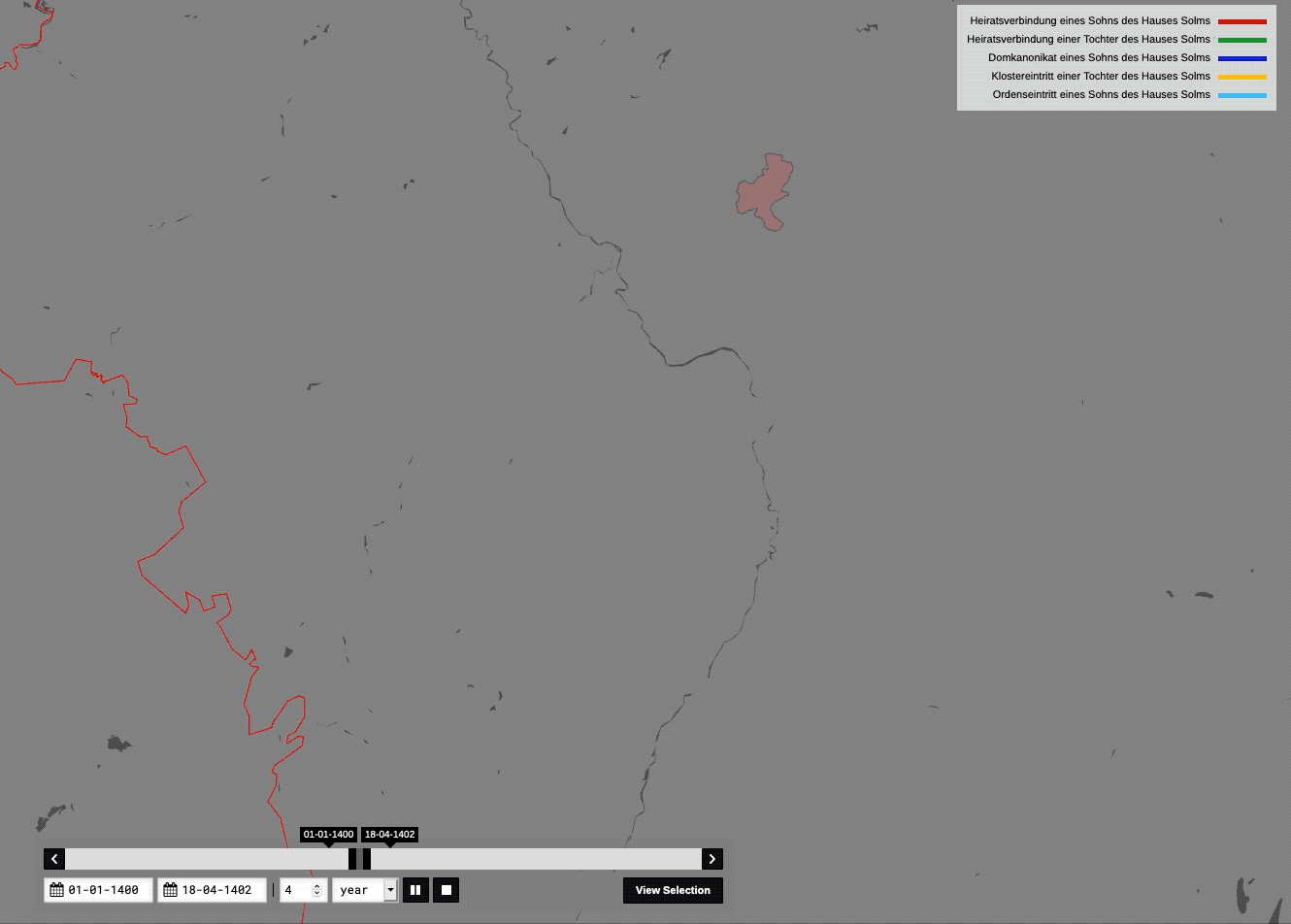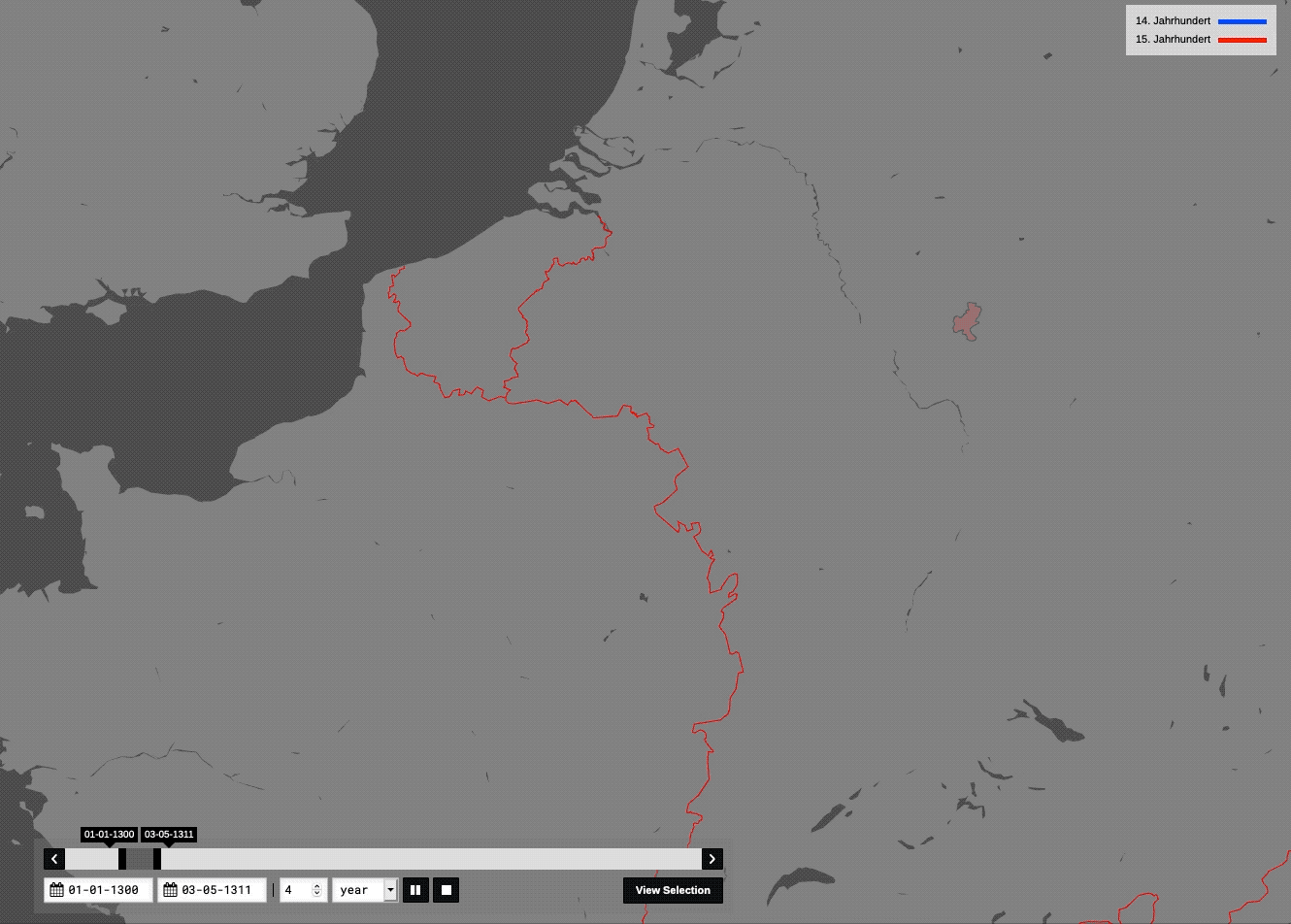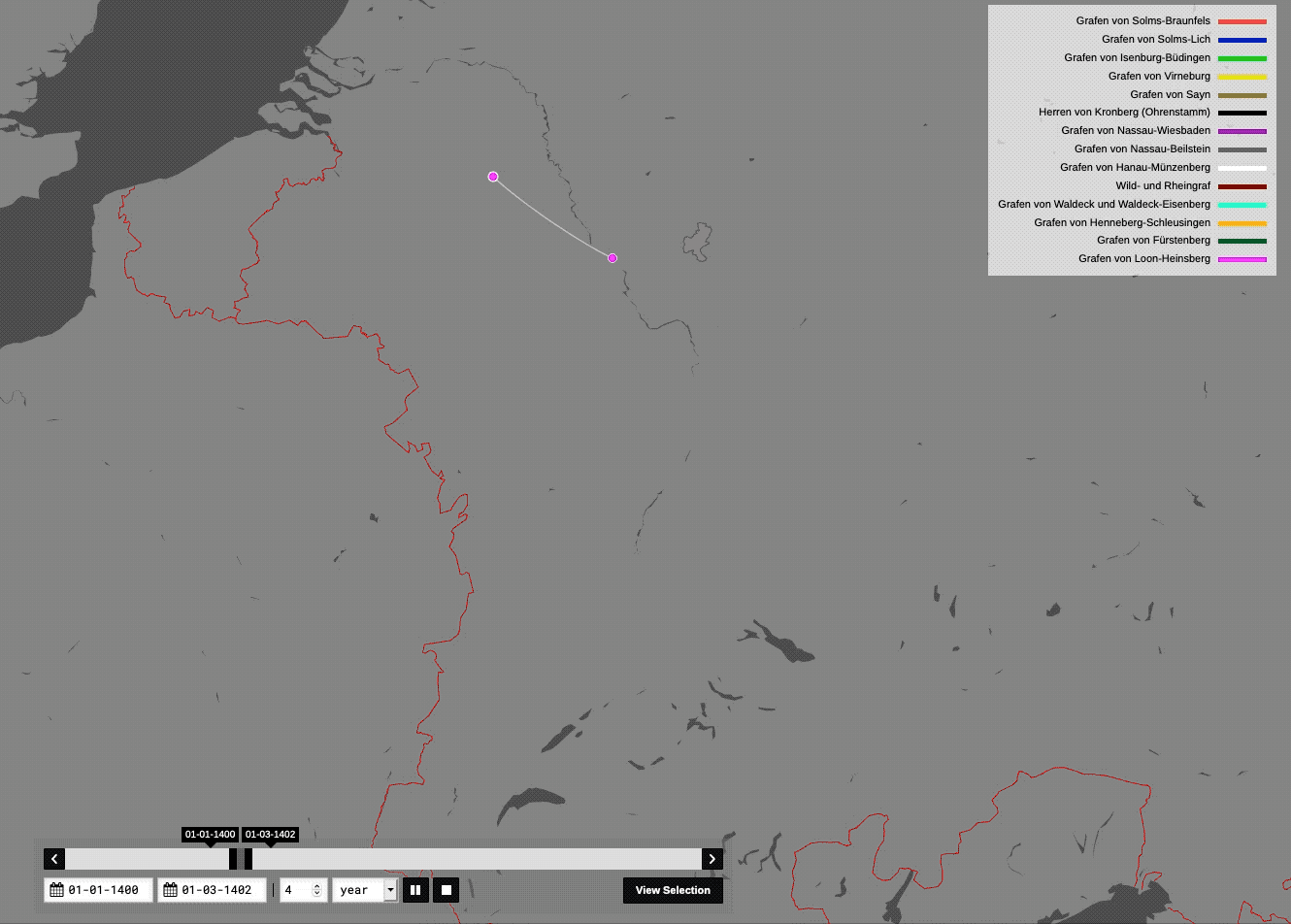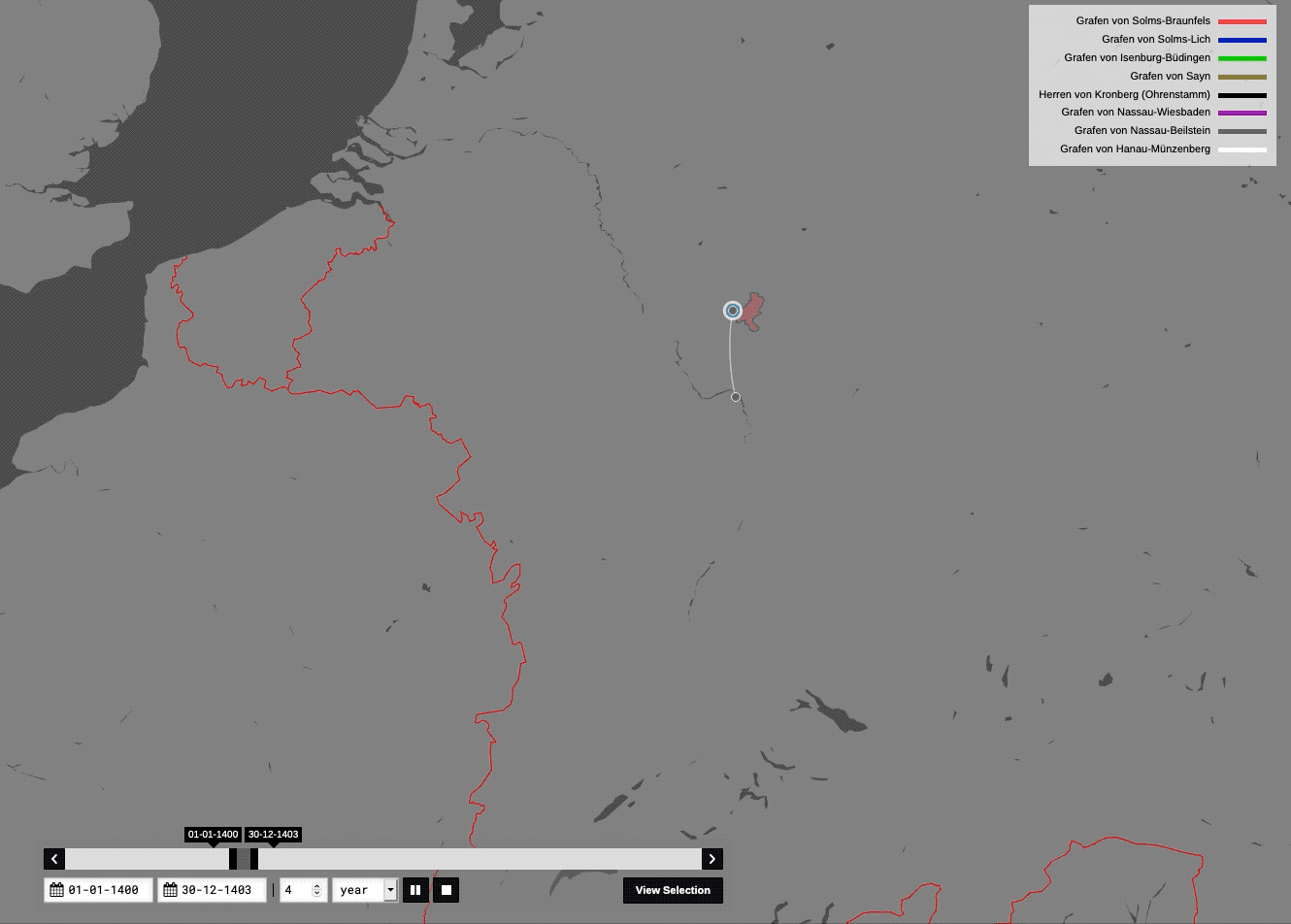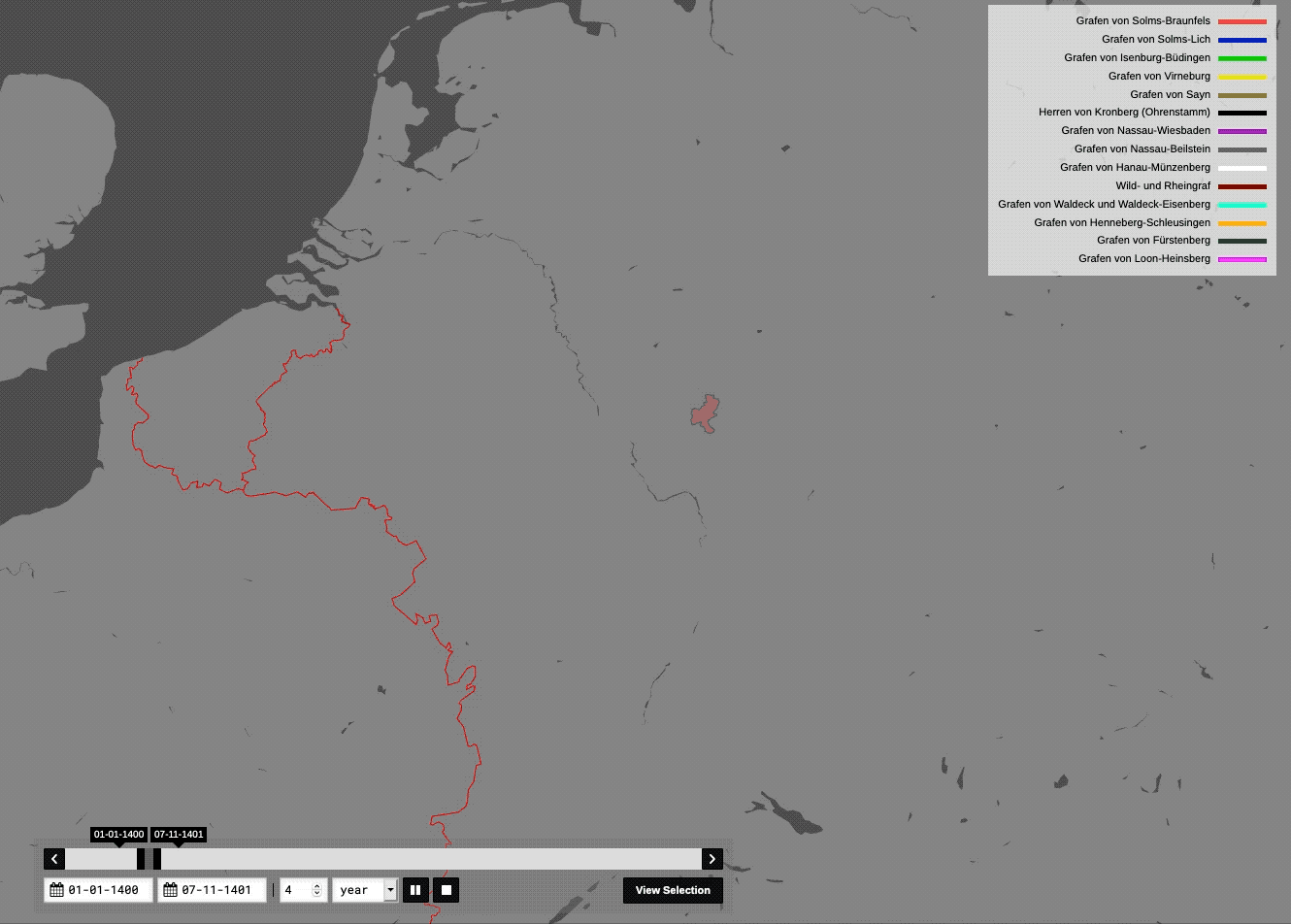Visualising Dynastic Spaces.
The Example of the Counts of Solms
The following article illustrates the possibilities of relational databases for researching the social history of the nobility in context of dynastic scopes of action. The evolution of the dynastic scope of action of the Counts of Solms during the 15th century will be visualised by using static and dynamic visualisations of a relational database. This dynastic space of action is formed by the residences of various dynasties and ecclesiastical institutions located around the County of Solms. The Counts were interrelated through marriage and cathedral canonries with these families and institutions.
The County of Solms (shown as a red area in the visualisations) was located between the two hegemonic territories of Hesse and Nassau, near the imperial city of Wetzlar. Until the beginning of the 15th century, this territorial location was decisive for its role as a minor actor. The Falkenstein inheritance of 1418 changed this status quo. As one of five noble families (Solms, Isenburg-Büdingen, Eppstein, Virneburg and Sayn), the Counts of Solms succeeded in gaining territory with the inheritance of the Counts of Falkenstein-Münzenberg, which extended the County’s domain into the Wetterau region, close to the center of the empire. The following visualisations show how the expansion of the territory correlated with the growth of the Counts’ dynastic sphere of action.
First, the County´s initial situation immediately before the inheritance must be presented, including all marriage connections the Counts conducted during the 14th century (see Visualisation 1). The Counts of Solms entered into dynastic connections to the west and southwest towards the Rhine as well to the region of Westphalia in the north, where the temporary branch of Solms-Ottenstein was formed. Marriage partners for the daughters of the dynasty were only selected from a very limited area around the County which is highlighted through different colouring of the connection points (marriages of men = red; marriages of women = green). A glimpse at the genealogies of the Count’s house shows that these daughters were predominantly married to partners of the lower nobility. By contrast, the spouses of the ruling Counts of Solms were selected mostly from more distant families, and the majority of these women belonged to the higher nobility. Thus, the social differences regarding the choice of marriage partners of Counts and Countesses of the house are clearly manifested in the dynastic sphere. Regarding the connections to the cathedrals (nodes in blue), it is underlined on the one hand that the various branches of the house were able to acquire no less than five canonries in Cologne during the 14th century (e.g., in Mainz only one). On the other hand, the foundation of the Ottenstein branch in the north of the empire immediately enabled the access to the cathedral chapters in Münster and Minden for the Count’s house. With the Falkenstein inheritance of 1418, but also on account to the end of the Solms-Ottenstein line, the dynastic sphere of the Count’s House of Solms changed starting c. 1418 (see Visualisation 2).
The Rhine remained of great importance to the Counts as an important communication area within the Holy Roman Empire, while connections to the north were now completely interrupted. Furthermore, the Counts of Solms ensured the consolidation of their rule in the Wetterau (the region in the north of Frankfurt) through marriages with families next to the newly acquired territory. Thus, the dynastic connections of the Count’s house became more heterogeneous from c. 1400 onwards. Both, in terms of the geographical and social origins of their marriage partners. The majority of the marriage partners (Counts and Countesses) now belonged to the higher nobility. The emerging dynastic area, with its expansion towards the west, remained fairly constant until c. 1475. Subsequently, the Count’s house entered into a new period of dynastic relations.
Constant connubia with the high nobility, an economically as well as politically expanded scope of action and an increasing presence at princely courts and imperial diets led to social advancement. The results of this development were three marriages with dynasties located entirely outside the previous dynastic area of the Count’s house. These marriages with the Waldeck, Fürstenberg and Henneberg dynasties were arranged at the courts of the Solms princely feudal lords. This reflects the increasing importance of the Counts of Solms inside the Empire, and indicates that Jörg Peltzer’s observation “the higher the rank, the more distant the view” also applies for the non-princely high nobility. By visualising the combined dynastic spaces of the two centuries (see Visualisation 3), the different developments become visible (14th century = blue; 15th century = red). The comparison reveals the elimination of the relationship to dynasties of the north and a stronger focus on the area of the left bank of the Rhine.
The previously presented connections to the residences of the married dynasties show contacts of the 1st degree. However, each of these connected dynasties had its own dynastic sphere, which was based on its personal dynastic politics. By visualising all further connections of the related dynasties, the spatial significance of the contacts becomes apparent. These 2nd degree contacts show the dynastic scope of action of the noble families inside the empire. Since the access to cathedral chapters was usually regulated by co-optation, marriage kinship played a significant role for the entry into the cathedral chapters. Therefore, the visualisation of 2nd degree contacts enables to determine which cathedral chapter was part of the families’ dynastic space.
The visualisation of all the 2nd degree contacts of the Counts of Solms and their kinship reveals a far-reaching dynastic network of the non-princely high nobility for the 15th century (see Visualisation 4). Some of the dynastic spaces can be directly noticed, while others need deeper examination to be identified. The most visible are the dynasties on the edge of the network; the houses of Fürstenberg, Loon-Heinsberg, Henneberg, Waldeck and Virneburg. For instance, the House of Fürstenberg has no intersection with the other dynasties in this comparative group, and the House of Henneberg also operates in a completely different space in the east of the Empire.
Visualising solely the Counts of Solms with these distant dynasties, it becomes visible that each of these dynasties can be located in a different region of the empire (see Visualisation 5). Thus, the dynasties shared only a few nodes.
The situation is reversed in case of the close marriage connections (see Visualisation 6). An independent sphere of action is hardly recognisable and the individual dynasties are considerably more interconnected. Only selectively they established connections outside this network. Thus, the visualisations prove that the marriage connections of the Counts of Solms can be divided into two categories: a distant marriage circle and a close marriage circle. While the close marriage circle was strongly interconnected, the distant marriage circle was less connected. However, the cathedral chapter can be identified as a shared institution of both marriage circles.
By visualising the connections between dynasties and cathedral chapters, it becomes clear how important the chapters have been as a junction for cultivating the dynastic networks of the high nobility. Almost all the dynasties were represented in the three Rhenish cathedral chapters of Cologne, Mainz and Trier. Whereby most of the threads converged in Cologne; nine dynasties had a family member in this chapter.
As demonstrated, the database enables to visualise the dynastic spheres of action of dynasties in relation to the surrounding actors. Various filter options allow to extract different types of connections (i.e., cathedral canonries, marriages of the men or women). That allows to reveal concealed dynastic structures behind imperial politics or the pre-modern state-building process.
